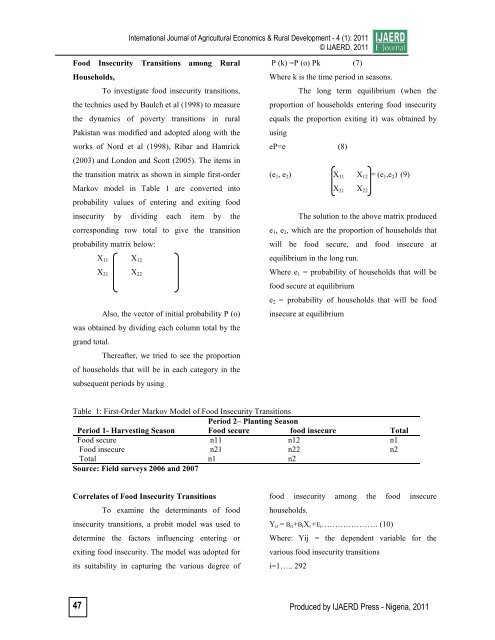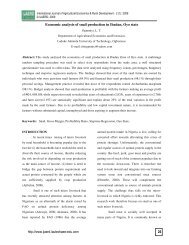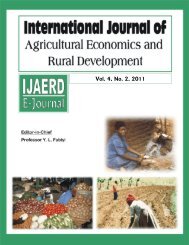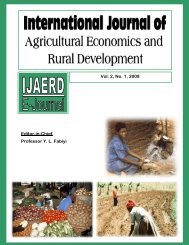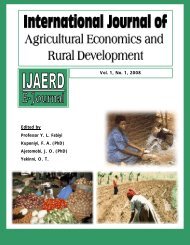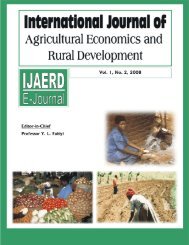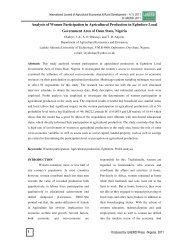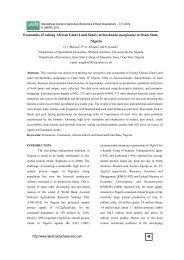Vol 4 No 1 2011
to download the whole journal - Lautechaee-edu.com
to download the whole journal - Lautechaee-edu.com
- No tags were found...
Create successful ePaper yourself
Turn your PDF publications into a flip-book with our unique Google optimized e-Paper software.
International Journal of Agricultural Economics & Rural Development - 4 (1): <strong>2011</strong><br />
© IJAERD, <strong>2011</strong><br />
Food Insecurity Transitions among Rural<br />
Households,<br />
To investigate food insecurity transitions,<br />
the technics used by Baulch et al (1998) to measure<br />
the dynamics of poverty transitions in rural<br />
Pakistan was modified and adopted along with the<br />
works of <strong>No</strong>rd et al (1998), Ribar and Hamrick<br />
(2003) and London and Scott (2005). The items in<br />
the transition matrix as shown in simple first-order<br />
Markov model in Table 1 are converted into<br />
probability values of entering and exiting food<br />
insecurity by dividing each item by the<br />
corresponding row total to give the transition<br />
probability matrix below:<br />
X 11 X 12<br />
X 21 X 22<br />
Also, the vector of initial probability P (o)<br />
was obtained by dividing each column total by the<br />
grand total.<br />
Thereafter, we tried to see the proportion<br />
of households that will be in each category in the<br />
subsequent periods by using<br />
P (k) =P (o) Pk (7)<br />
Where k is the time period in seasons.<br />
The long term equilibrium (when the<br />
proportion of households entering food insecurity<br />
equals the proportion exiting it) was obtained by<br />
using<br />
eP=e (8)<br />
(e 1 , e 2 ) X 11 X 12 = (e 1 ,e 2 ) (9)<br />
X 21 X 22<br />
The solution to the above matrix produced<br />
e 1 , e 2 , which are the proportion of households that<br />
will be food secure, and food insecure at<br />
equilibrium in the long run.<br />
Where e 1 = probability of households that will be<br />
food secure at equilibrium<br />
e 2 = probability of households that will be food<br />
insecure at equilibrium<br />
Table 1: First-Order Markov Model of Food Insecurity Transitions<br />
Period 2– Planting Season<br />
Period 1- Harvesting Season Food secure food insecure Total<br />
Food secure n11 n12 n1<br />
Food insecure n21 n22 n2<br />
Total n1 n2<br />
Source: Field surveys 2006 and 2007<br />
Correlates of Food Insecurity Transitions<br />
To examine the determinants of food<br />
insecurity transitions, a probit model was used to<br />
determine the factors influencing entering or<br />
exiting food insecurity. The model was adopted for<br />
its suitability in capturing the various degree of<br />
food insecurity among the food insecure<br />
households.<br />
Y IJ = B O +B I X I +E I ………………… (10)<br />
Where: Yij = the dependent variable for the<br />
various food insecurity transitions<br />
i=1….. 292<br />
47<br />
Produced by IJAERD Press - Nigeria, <strong>2011</strong>


